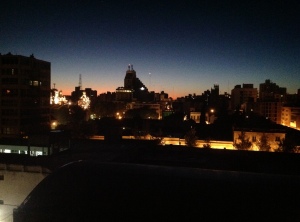
“I am still arriving.” That is how it feels more than two months after having ‘landed’ in Córdoba, Argentina to live and work for the next three years. A few days ago, I tried, with mixed success, to express this to my Spanish teacher. “When did you arrive in Córdoba” (¿Cuándo llegaste en Córdoba?) she asked me. “I am still arriving” (Todavía estoy llegando) I said. She looked puzzled; we were working on words and concepts for time, and she wanted to know (a good exercise it seemed) how many days or weeks it had been since I had arrived here. But hearing her question, I was suddenly aware of my feelings of ongoing bewilderment (and sometimes bemusement) at trying to enter into this place and make it my home. Aware of how far I felt from having really arrived here. It was not so easy to respond to her question. After a few halting efforts to express these feelings (trying to find the right conjugation to convey my sense that “arriving” was an ongoing process), she acknowledged that she understood. “Muy sutil” she said, smiling at my willful disregard of the lesson; but also recognizing that, indeed, the question of what it meant to arrive in a place was not always so easy to answer.
I wonder how long I will be arriving here? When, if ever, I will begin to feel the place as, if not my home, then at least a place where I somehow belong? A common question, I suspect, for anyone who has ever moved (or been moved) from one place to another. There are words for such experience: uprooted, displaced, exiled. These are strong terms and in some ways they do not really apply to me, certainly not in the way they do to many so many others in this country and elsewhere who find themselves not only displaced but marginalized, forsaken. Forced from their home place by circumstances beyond their control and hanging on, often precariously, in a new place. This is not my experience. I, after all, came to Argentina willingly, to help start a study abroad program for my university. I am here with my wife, Jennifer, four of our five children (the eldest is back in the U.S. in college), and a wonderful group of colleagues and students with whom we have the privilege to live and work. And I have been given resources to carry out this work and to sustain my life here.
Still, there is a profound sense of displacement and loss that is woven into this experience, even as I delight at the prospect of giving myself to the great and immensely challenging adventure of this work. I have left so much behind. And I am often acutely conscious, walking through the streets of the city, of being a stranger here. This loss is real and I begin to realize that room must be made for grieving all that has been lost in coming here, even as I continue opening myself to the work of learning what it might mean to be here. How to be here. How to open myself to the life of this place, its people, language, cultural traditions, food, politics, social struggles, beauty–todos! We are all still arriving and will be I suspect for some time to come. Perhaps we will be doing so until the day of our eventual departure.
For the moment, I begin to see that it is enough to do what I can to pay attention, remain open, curious. To try noticing and giving some expression to all that is unfolding around and within me. To the lapacho trees that have burst into glorious pink blossoms across the city. To the loros, glinting brilliant green in the early morning sun, talking and talking and talking as they fly overhead in sharp sweeping arcs. To the night sky, still new and mostly unknown to me, but gradually revealing itself and becoming part of me. To the criollitos, sprinkled in sugar, beckoning to me from the window of the panaderia ‘Las Delicias’ (we succumb and bring a bag home for breakfast). To the motos–carrying one, two, three, or even four persons and on this day waving flags for Talleres Fútbol Club–tearing madly down Rafael Nuñez on the way to the match. To signs of political and economic unrest–a large crowd gathered downtown on a cold winter day giving voice to their dissatisfaction over the state of the economy. To the Sierras Chicas–rising to the west of the city and just visible through the trees in our neighborhood.
And to the people who are beginning to enter into our lives: Roberto, who looks after our street; Belén, from whom we bought lights for our house, and Marina, whose empanadas have already become a staple in our house. We are getting to know–a little bit–some of the people who inhabit our neighborhood. Brief exchanges–in our ‘work in progress’ Spanish–with these and other persons become yet another means kindling intimacy and coming to know the place.
And to those with whom we have been given the privilege to work: our students, recently “arrived” from the United States and opening themselves little by little to the life of the place; our colleagues at La Universidad Católica de Córdoba; and our new friends at the praxis sites at El Gateado, Nuestro Hogar III, and Argeullo–all communities that are struggling in their own way to maintain a foothold in contemporary Argentina.
A glimpse only. And hardly enough to begin feeling or knowing what this place is, or what it might become for us. But a beginning nonetheless.
Poco a poco, we are arriving, learning what it means to be here.




